Lemony Hummus Without Garlic (3 Ways)
Hummus needs no introduction. It’s everyone’s favourite Middle Eastern condiment. And my lemon hummus without garlic is flavourful, super creamy and utterly delicious. Use dried chickpeas (soaked or unsoaked) or canned chickpeas.
It didn’t take long for me to fall in love with Middle Eastern cuisine after my first hit of hummus. And I’ve been making hummus ever since.
Homemade hummus always trumps the grocery store ones. And there are many great recipes out there. But this one is my favourite, by far.
This garlic-free hummus is utterly delicious. It shines with the nutty tahini flavour, followed by a lovely lemon kick. But it’s the velvety texture of this hummus that keeps me coming back to this easy hummus recipe.
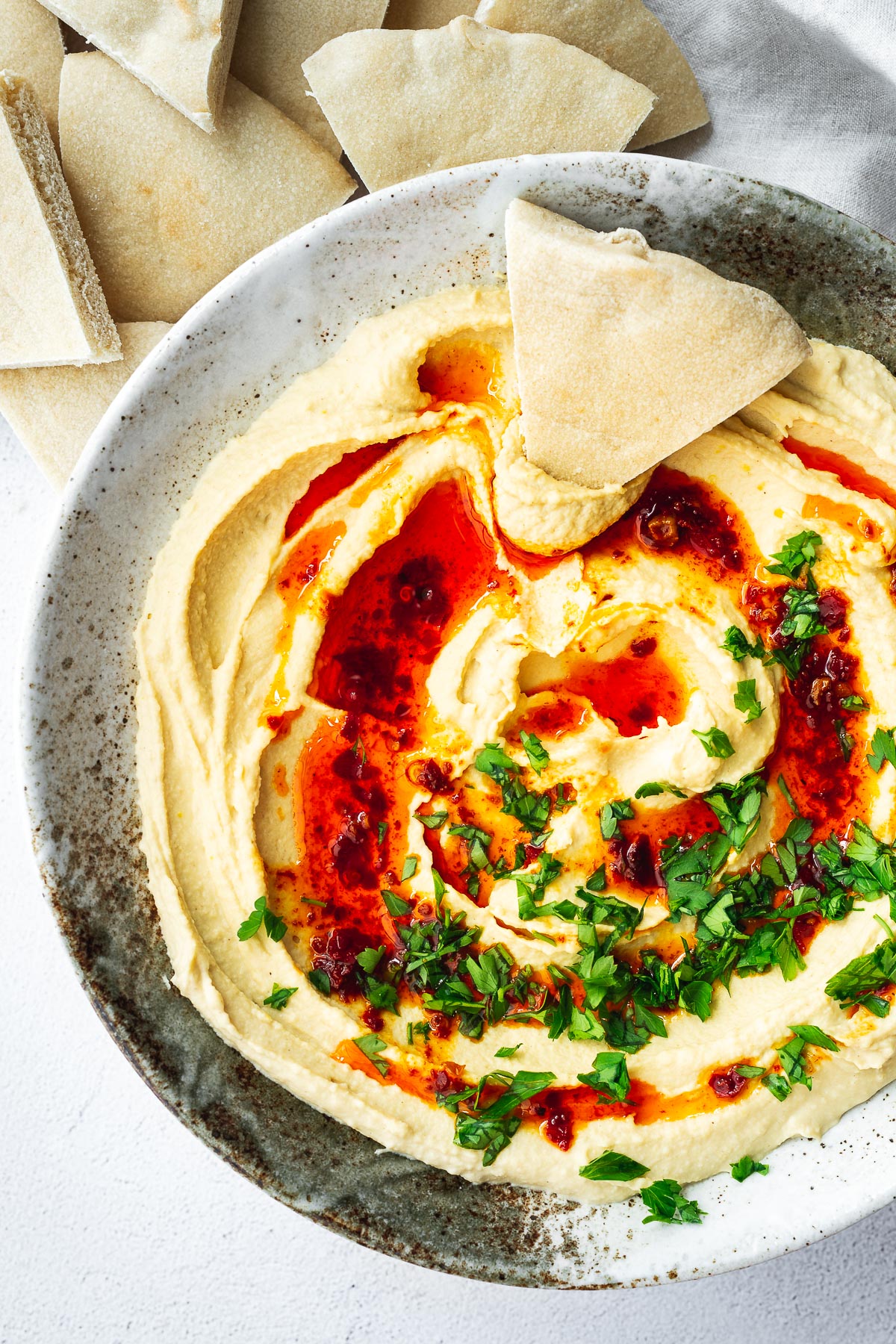
Hummus ingredients
The main ingredients of traditional hummus are cooked chickpeas and good-quality tahini. Tahini is a paste made from ground sesame seeds. To learn more, see how to make tahini at home.
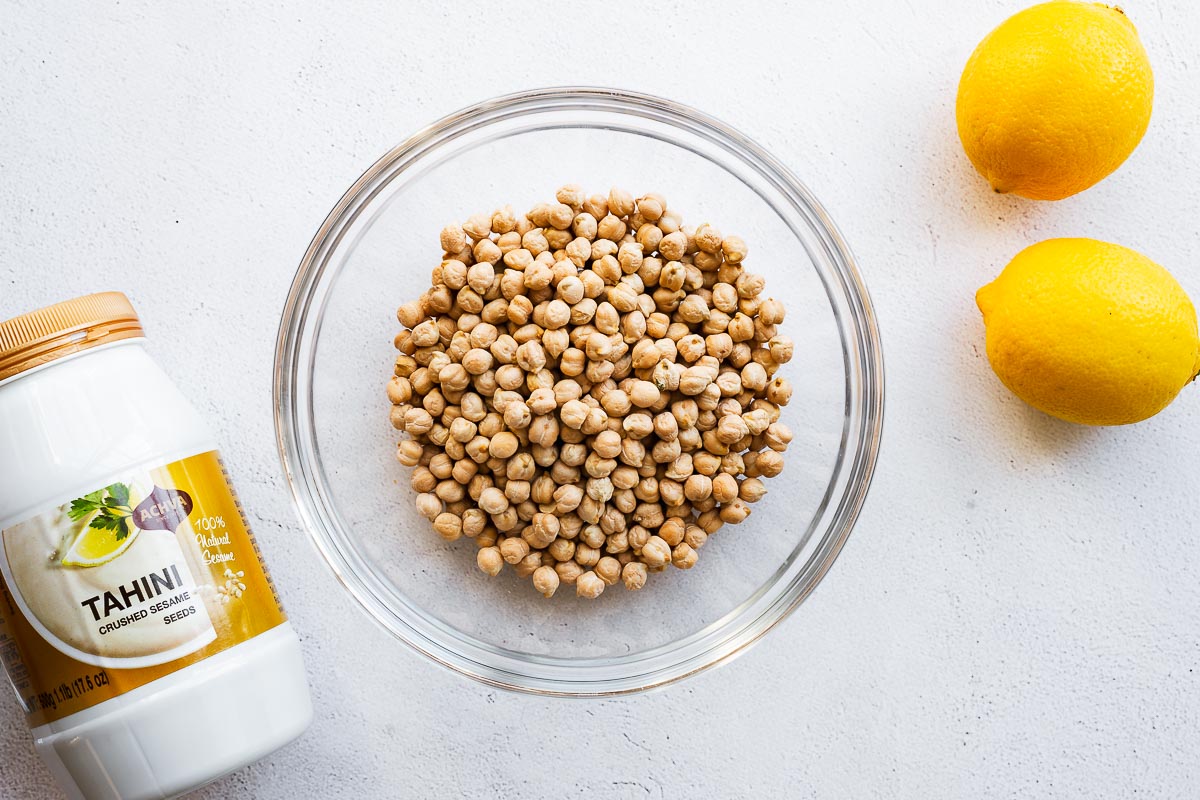
Authentic hummus can also include lemon, garlic cloves, or spices. But you can play around with the flavours. Try it with roasted red peppers or cooked beetroot for a beautiful pink hue.
I recommend starting with this basic hummus recipe to get the technique down before you begin experimenting.
Basic Hummus Ingredients
- Chickpeas: These legumes are also known as gram, garbanzo, garbanzo beans, or Egyptian peas. You can use dry chickpeas, canned (tinned), or jarred chickpeas for hummus as long as they are well-cooked and soft.
- Tahini: After properly cooked chickpeas, tahini has the most significant impact on the final results, especially in a recipe with plenty of tahini. Find good-quality authentic tahini or see how to make tahini for a homemade version.
- Baking soda: This allows the dried chickpeas to soften faster during cooking. So, you can leave out the baking soda (also called bicarbonate of soda), but you will need to cook the chickpeas for longer. You only need baking soda for dried chickpeas cooked on the stove, not for the pressure cooker method or canned chickpeas.
- Cumin: I used to add a pinch of ground cumin directly to the hummus, but adding it to the cooking water lends a subtle earthy flavour that I love. Ground cumin works best for smooth, homogenous hummus, but you can use cumin seeds in a pinch.
- Lemon: It can’t be lemony hummus without some lemons. This recipe uses lemon zest and lemon juice for that luscious lemon kick I adore.
- Ice cubes: You can also use ice water, but ice cubes are perfect to aerate the hummus during blending.
Related Post: How to make tahini
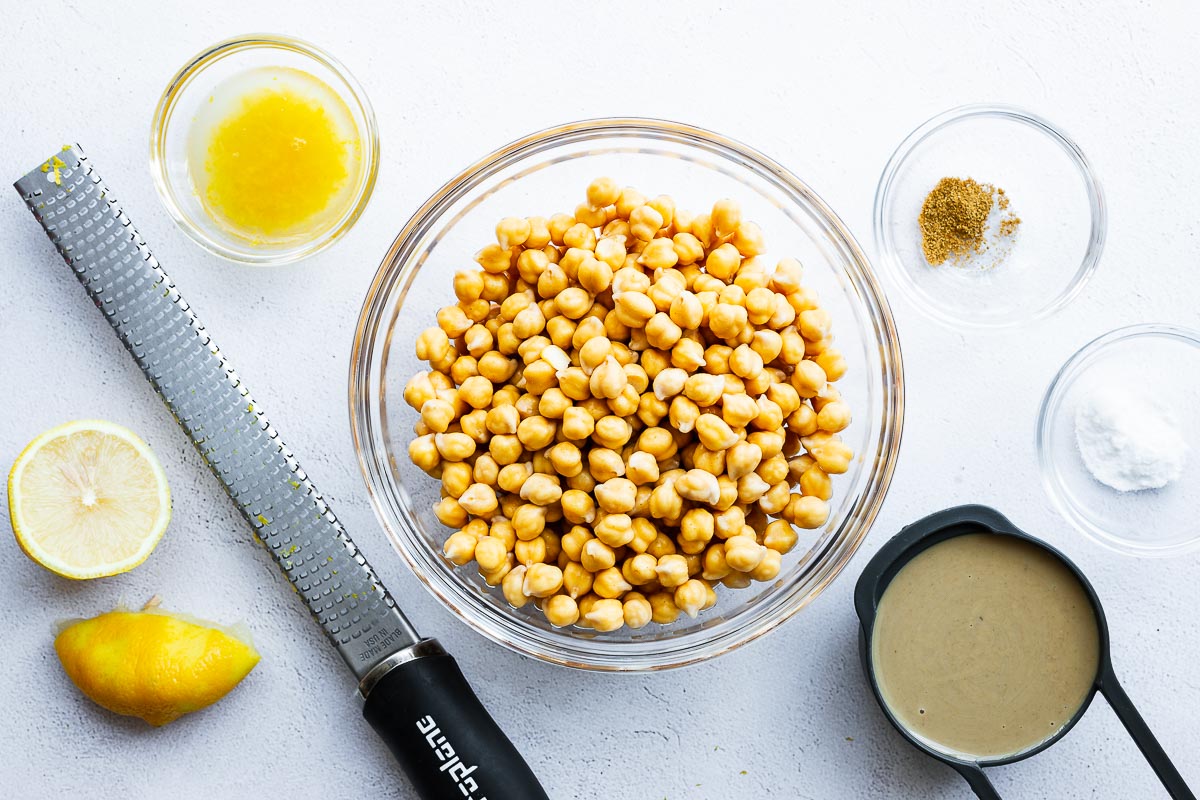
Chickpea quantity conversions
This recipe uses three cups of cooked chickpeas, regardless of the cooking method. These handy dried to cooked and cup to gram conversions have you covered no matter what you have at home.
3 cups cooked chickpeas = 480 grams cooked chickpeas
480 grams cooked chickpeas = 200 grams dried chickpeas
200 grams dried chickpeas = 1 cup dried chickpeas
15 oz can of chickpeas (or 400 gram tin of chickpeas) = 1.5 cups drained chickpeas
So, for three cups of cooked chickpeas, start with one cup of dried chickpeas or two cans of chickpeas.
How to cook chickpeas for hummus (3 ways)
After you cook the chickpeas, how you make the hummus is the same. If you follow the tips and tricks for creamy hummus, your hummus will be silky smooth and delicious no matter your cooking method.
When I have the time to plan, I use dry chickpeas soaked overnight in water with baking soda (bicarbonate of soda). And when I have dried chickpeas but forgot to soak them overnight, I pop them into the Instant Pot. Or, if I want delicious hummus ASAP, I reach for the canned chickpeas.
The key to silky smooth hummus is a very soft cooked chickpea blended while still warm.
How to cook dried chickpeas for hummus
Start the night before and place a cup of dried chickpeas in a bowl along with ¾ teaspoon of baking soda. Cover the chickpeas with lots of water. They will expand, so add enough water to keep them submerged.
You can cook dried chickpeas on the stove without soaking, but it will take longer to get them super soft.
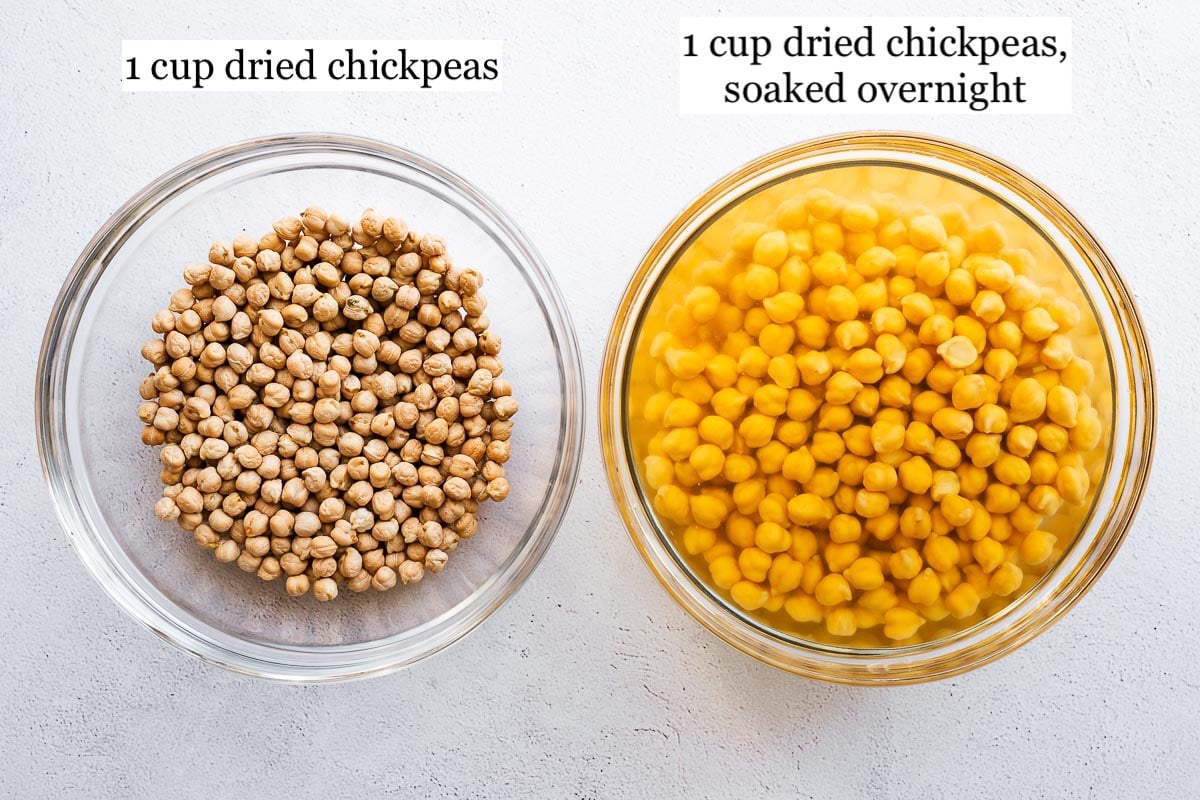
The next day, drain the soaked chickpeas. Grab a medium saucepan, for which you have a lid. And add the chickpeas, half a teaspoon of baking soda, and six cups of water.
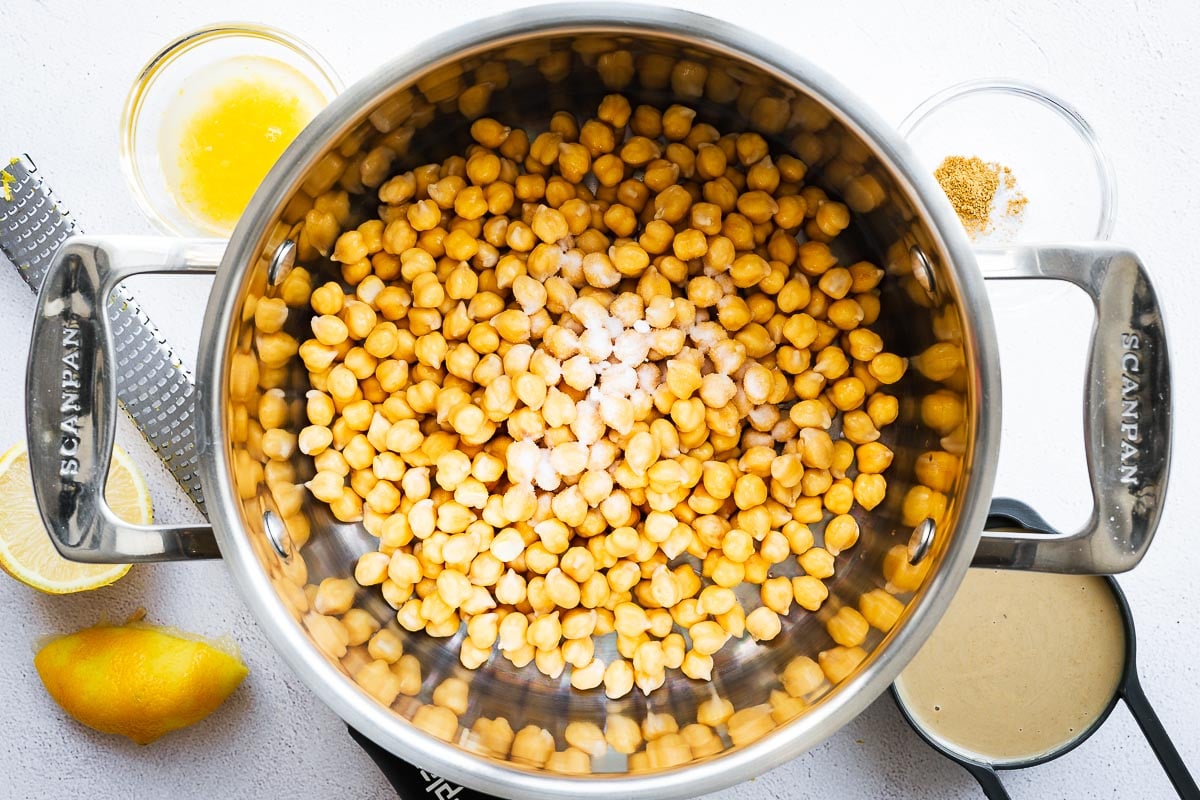
Place the saucepan on high heat and bring to a boil. Skim off any scum or skins that rise to the top. Then turn the heat down to low, cover and allow to simmer.
After 20 minutes, add a teaspoon of salt and a large pinch of ground cumin. Keep cooking until your chickpeas are very soft – anything from another 10 to 30 minutes (depending on how old your chickpeas are and how long they were soaked).
How to cook chickpeas in an Instant Pot (no soaking)
Add a cup of chickpeas and a large pinch of ground cumin to the Instant Pot insert (or another pressure cooker). Add enough water to cover the chickpeas by an inch (2.5 cm).
Cook the chickpeas on high pressure for 50 minutes. And allow the pressure to release naturally.
The chickpeas should be soft and easily squished between your fingers. If not, cook at high pressure for another 5 minutes, then manually release the pressure valve.
I use the Instant Pot Duo 7-in-1.
How to cook canned chickpeas for hummus
Many recipes don’t call for cooking canned chickpeas because they are technically already cooked. And you certainly can skip this step and jump straight to blitzing the chickpeas if you have a high-speed blender like a Vitamix (which I don’t).
However, for the smoothest hummus, it is best to use super soft cooked chickpeas that are still warm. Canned chickpeas are cooked but still too firm.
Drain two tins of chickpeas (three cups / 480 grams) and gently rub the chickpeas between two tea towels to remove some of the skins. Take care not to squish the chickpeas.
Then, add the drained, peeled chickpeas to a medium saucepan with a teaspoon of salt and a pinch of cumin and cook for 15 minutes until soft and tender.
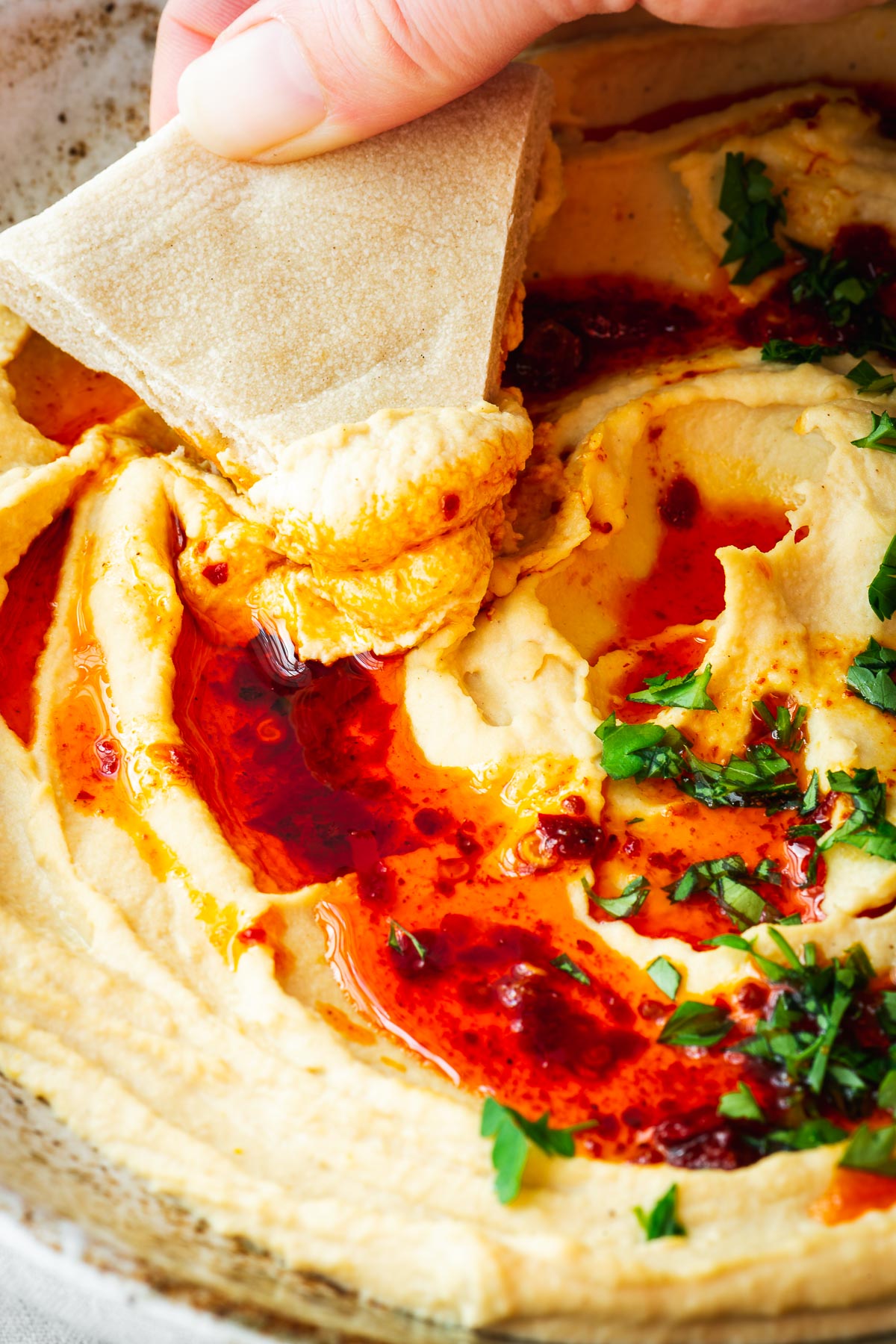
How to make hummus
Cook the chickpeas. Then drain them, reserving the cooking water. You will use the chickpea-and-cumin flavoured water to thin your hummus, but you can also use any remaining cooking water in soups and stews.
Add the drained, warm chickpeas to the bowl of a food processor with the tahini, lemon zest, lemon juice, ice cube, half a teaspoon of salt, and two tablespoons of cooking water.
Blitz into a smooth paste. You can also use an immersion blender or high-speed blender.
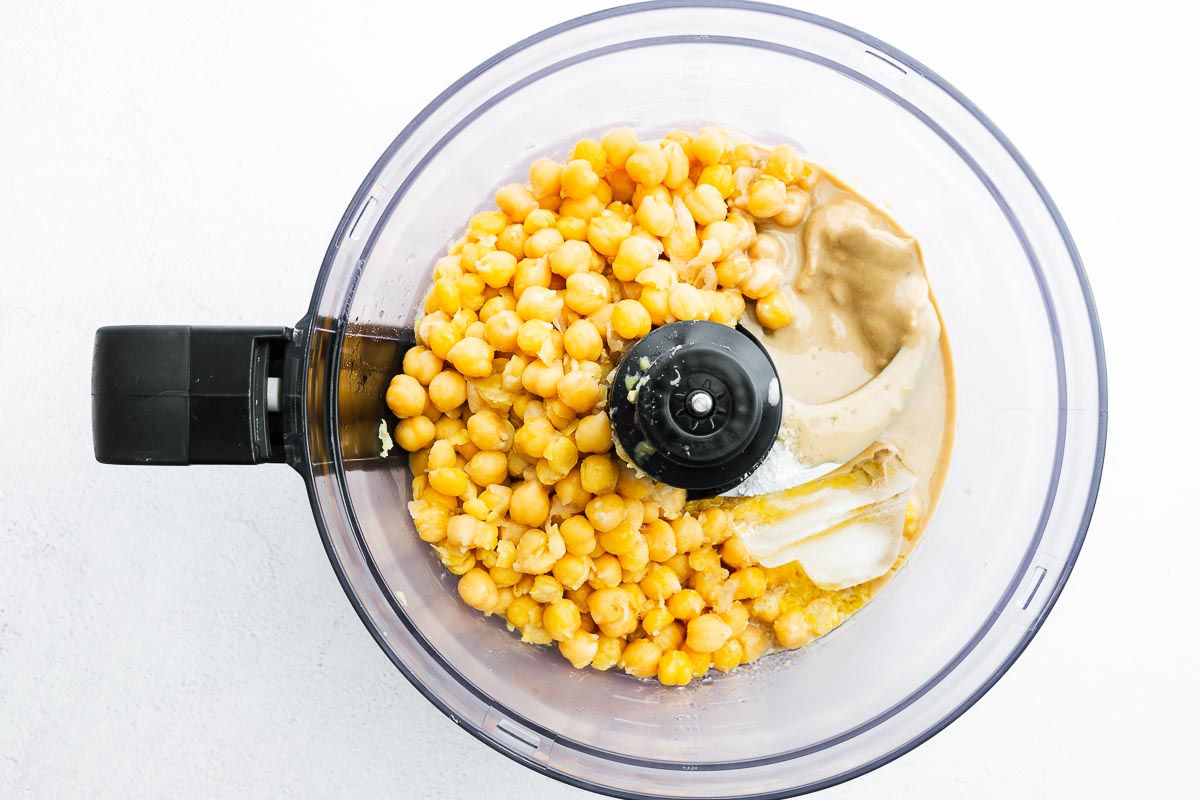
Add more tahini, lemon juice and salt. I often add another half teaspoon of salt and a squeeze of lemon juice. And if the hummus is too thick, loosen it with more chickpea water.
Once the taste is to your liking, run the food processor for a few minutes until the hummus has a silky, smooth, and creamy texture.
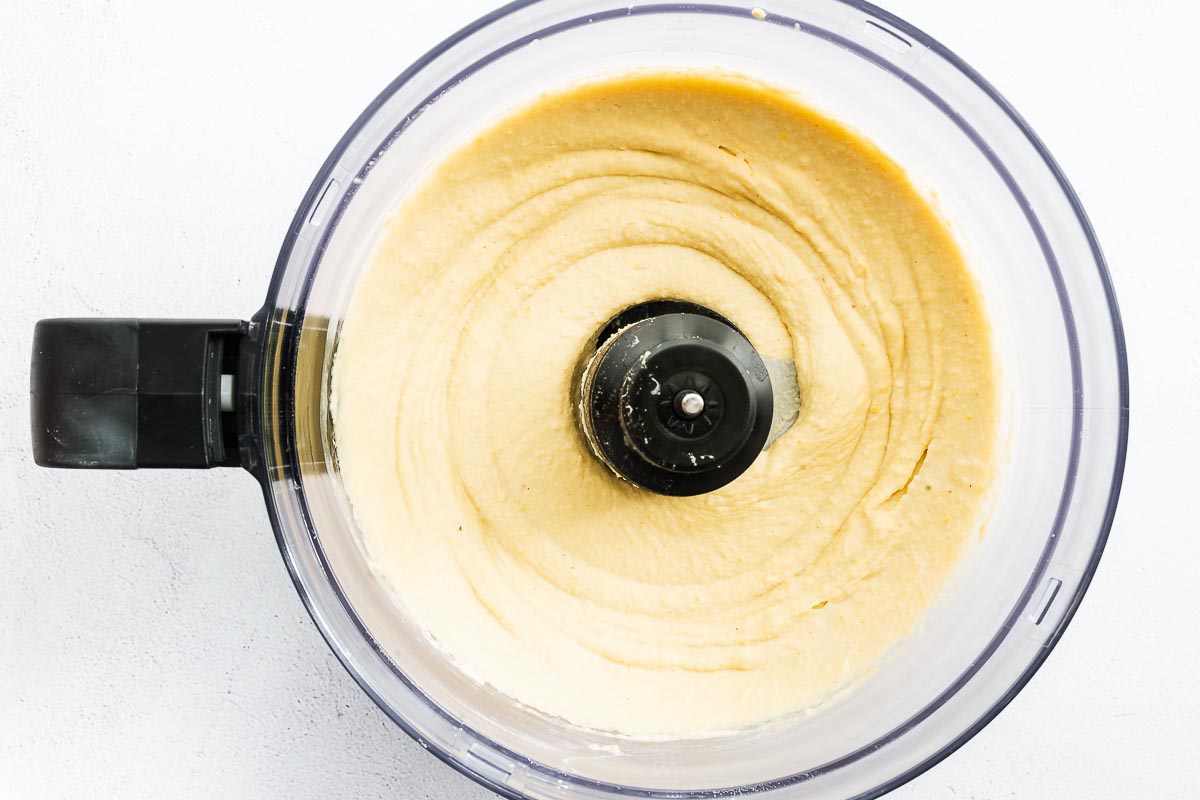
To serve, spread the hummus in a shallow bowl and top with a generous glug of extra virgin olive oil and toppings like a sprinkling of herbs, chopped nuts or chilli flakes. See serving suggestions for more ideas.
Tips & tricks for the ultimate hummus
Whether you use soaked dried chickpeas cooked on the stovetop, unsoaked chickpeas in the instant pot or canned (or jarred) chickpeas, these tips will guide you to make the best hummus.
These tips are an adaptation of Noor Murad’s hummus recipe from Ottolenghi Test Kitchen: Shelf Love by Noor Murad and Yotam Ottolenghi. I have many Ottolenghi cookbooks and many hummus recipes. But with Noor’s technique, we have officially reached peak hummus. She even taught Yotam Ottolenghi a thing or two!
While you can skip many of these steps if you’re in a rush and still have a delicious chickpea dip, I promised you a recipe for the ultimate hummus. And this is, without a doubt, how you will reach the pinnacle of hummus excellence.
1. Chickpeas for hummus should be very soft and tender
Straight from the tin, chickpeas are not soft enough for the best, creamiest hummus. This is why we cook them for 15 minutes.
2. Use warm chickpeas
They are easier to blend into super smooth hummus.
If you find yourself short on time (or too lazy) to cook chickpeas on the stove, at the very least, let your chickpeas rest in boiling water while you gather your ingredients.
3. Save the salted cooking water
And use it to thin out your hummus. But you can also use it as a base for soups and stews!
4. Remove the chickpea skins
Agitate the cooked chickpeas at the end of cooking and scoop and discard the skins that rise to the surface.
With tinned chickpeas, you can roll them between two kitchen towels to remove some of the skins before cooking them.
Don’t worry if you don’t get all of the skins off.
5. Add ice cubes when blending hummus
Many recipes use ice water, but ice cubes work a treat! This aerates the hummus for a smooth, almost fluffy hummus.
6. Don’t add olive oil
Yes, I know. I used don’t and olive oil in a sentence. There is a first time for everything.
This recipe uses plenty of tahini which has enough fat already. Definitely drizzle your hummus with good quality extra virgin olive oil when serving.
7. Use good quality authentic tahini
It should say tahini on the label, not sesame paste (which can be made from unhulled sesame seeds).
If you struggle to find authentic tahini from the Levant region (like Lebanon or Israel), you can make your own tahini from hulled sesame seeds.
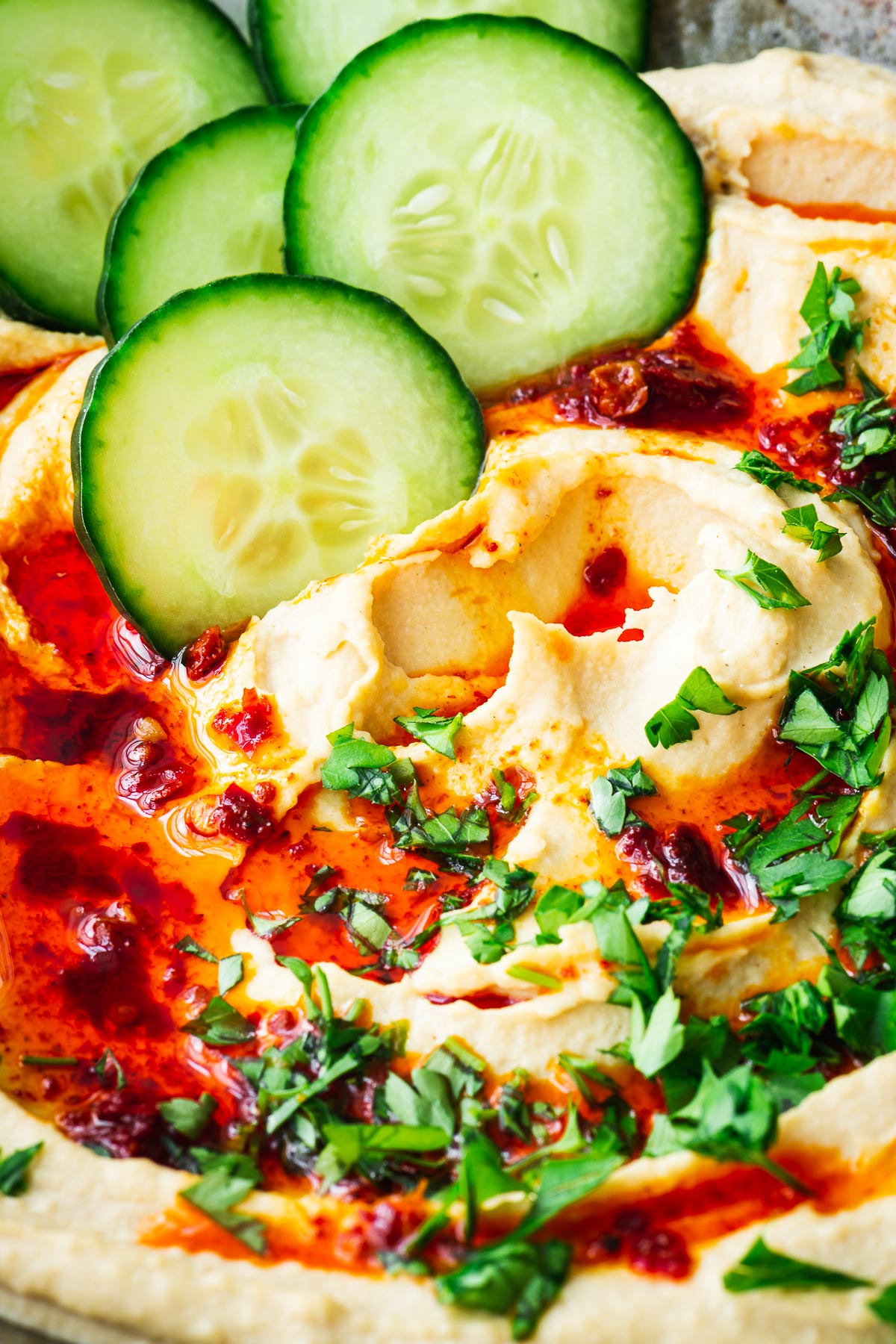
Serving suggestions
Spread the hummus in a shallow bowl, creating ridges and dips with the back of a spoon. Sprinkle with toppings and a drizzle of olive oil.
Possible toppings include
- roasted aubergine and chopped walnuts,
- a sprinkling of ground spices like paprika, chilli powder, za’atar, and harissa powder, or
- toasted pine nuts, chopped olives and green herbs, or
- a teaspoon of rose harissa paste mixed with a tablespoon of olive oil.
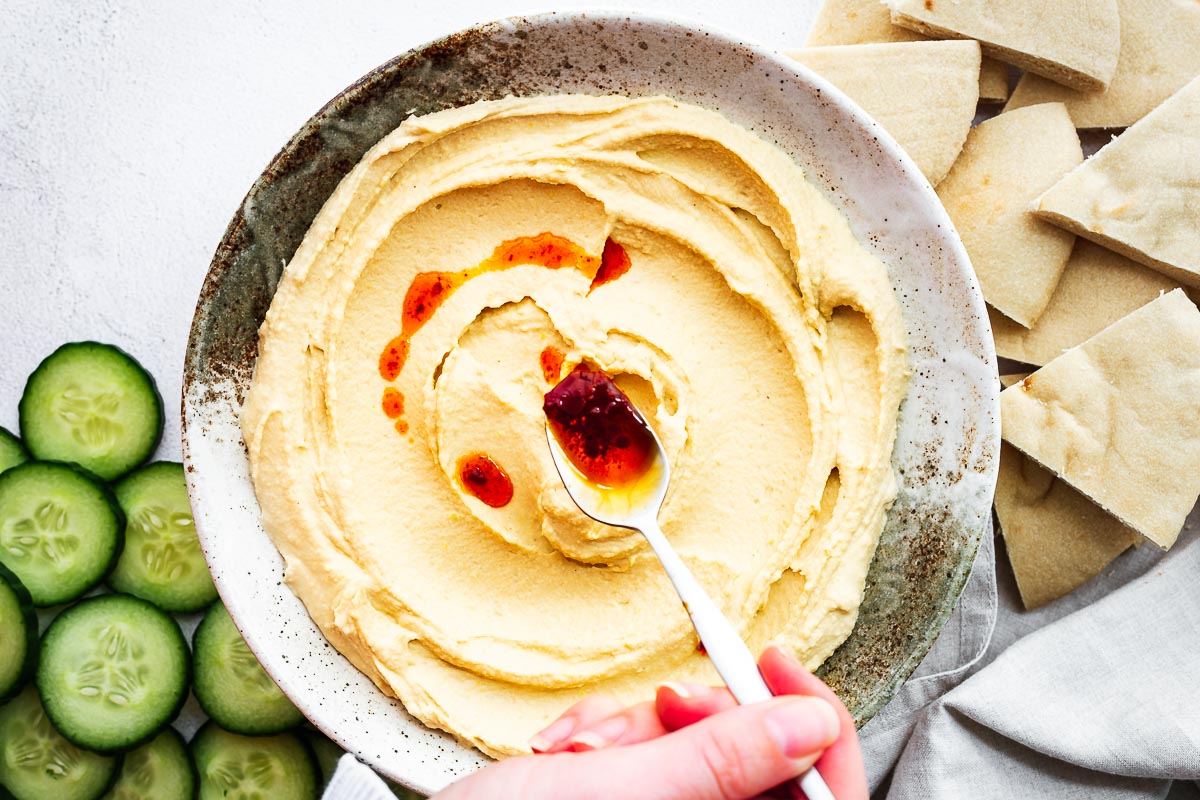
Serve it with toasted pita bread to scoop up the delicious hummus. For a healthy snack, serve a bowl of hummus with raw veggies.
But hummus is so much more than just a tasty dip. Use it as a sandwich spread or make a hummus salad dressing by thinning it with olive oil and water and drizzle over crunchy lettuce leaves or green salad.
Spread hummus on a large shallow platter and top with a grain salad like this bulgur wheat salad with tahini dressing.
Hummus Variations:
- Red pepper hummus: Drain a jar of roasted red peppers and blitz with the chickpeas before you add the cooking water.
- Roasted garlic hummus: Roasted garlic is significantly less pungent than raw garlic. It is sweet and mellow. Add three roasted garlic cloves to the food processor at any stage.
- Beetroot hummus: Cook a small, peeled beet (yellow, orange, red, or candy variety) with the dried chickpeas. Then proceed with the recipe, including the cooked beet. Alternatively, you can add raw beet to the food processor or blender.
- Harissa hummus: Add a tablespoon (or more) of rose harissa paste or harissa powder to your hummus and blitz until beautifully pink and smooth. Or mix a teaspoon of harissa with a tablespoon of olive oil and drizzle over the hummus. Learn how to make rose harissa or harissa powder if you can’t find it in the grocery store. Or create a homemade version from the best harissa substitutes that you may already have in your home.
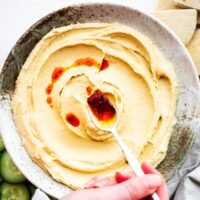
Equipment
- Large saucepan – or Dutch oven or instant pot
- Food processor – or a high-speed blender or immersion blender
Ingredients
- 1 cup dried chickpeas*, soaked overnight in plenty of water and ½ teaspoon baking soda (see notes for canned chickpea instructions)
- ½ teaspoon baking soda, if using dried chickpeas
- 6 cups water
- 1½ teaspoons salt, divided
- pinch of cumin
- ½ cup tahini
- 2 lemons, 1 tablespoon of finely grated zest and 3 tablespoons of lemon juice
- 1 ice cube
Instructions
- Drain the soaked chickpeas. Place them in a large saucepan, for which you have a lid, with half a teaspoon of baking soda. Add 6 cups of water.
- Bring to a boil on high heat. Skim off any foam that rises to the top. Then turn the heat down to low, cover and allow to simmer. Skim the top from time to time.
- After 20 minutes, add a teaspoon of salt and a pinch of ground cumin. Keep cooking until your chickpeas are very soft – anything from another 10 to 30 minutes (depending on how old your chickpeas are).
- Drain the chickpeas over a bowl and reserve the cooking water.
- Put the warm chickpeas into a food processor (or high-speed blender) with the tahini, lemon zest, lemon juice, ice cube, half a teaspoon of salt and two tablespoons of the cooking water. Blitz until smooth.
- Add more tahini, lemon juice and salt to taste. And if the hummus is too thick, loosen it with more chickpea water. Blitz for a few minutes until the hummus is silky smooth and fluffy.
- To serve, spread the hummus in a shallow bowl and top with a generous glug of extra virgin olive oil and toppings like a sprinkling of herbs, chopped nuts or chilli flakes. See serving suggestions for more ideas.
Notes
- Canned chickpea instructions: Use two tins of chickpeas (drained 3 cups / 480 grams). Drain the chickpeas, then gently rub them between two tea towels to remove most of the skins. Place the chickpeas in a saucepan with a teaspoon of salt and a pinch of cumin. Cook for 20 minutes until soft. See this harissa hummus recipe for the full instructions.
- Alternatively, see how to cook dried chickpeas without soaking them in an instant pot.
- See hummus ingredients for more ingredient details.
- Store hummus in an airtight container in the fridge for up to five days.
Love Middle Eastern cuisine?
If you love Middle Eastern flavours as much as I do, why not try another Middle Eastern recipe:
